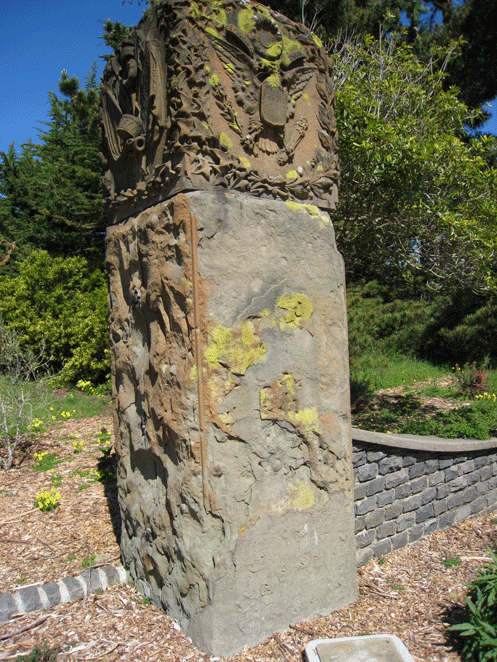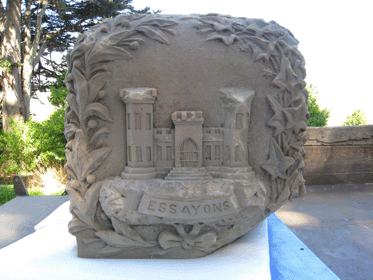
The Presidio Trust: Arguello Gate
The Arguello Gate at the Presidio National Park in San Francisco was built by the military in 1896. The grey sandstone gate consists of four piers with carved cubic capstones.
The two smaller piers are flanked by random coursed broken ashlar walls extending outward. The two larger piers have previously been moved back from their original location, and a short retaining wall of coursed ashlar basalt now connects them.

Before Restoration

After Restoration




Seasonal rain and weather caused significant erosion on the Arguello Gate. Many of the carved leaves and military emblems were cracked or broken. On many surfaces a hard crust had formed, and in many places spalled.
This problem was compounded by sprinkler irrigation systems which wet some areas on a regular basis.
In addition to erosion, the gate also suffered serious damage from a number of incidents. In 1996, a truck hit one of the smaller piers, knocking off the capstone. A large chunk of the capstone broke off; that piece was saved and stored along with the rest of the stone.
The two larger piers suffered from the corrosion and expansion of iron pins that were installed to hold the original iron gate.
The damage was so severe that the stones cracked in half. Additionally, one section of the basalt wall was significantly displaced.
The restoration of the Arguello Gate consisted of four main parts. The first phase was cleaning and removal of biological growth. A number of environmentally friendly products from ProSoCo were used, including Biowash for biological growth, and Fireplace Cleaner for carbon build‑up.
The bulk of the work involved the patching and repair of eroded surfaces. Unsound stone was first removed and the areas to be patched were given a mechanical key to hold the patch in place.
On pitch-faced surfaces, Jahn M70 repair mortar was used to approximate the original stone. In areas where the original surface was hollow underneath, stainless steel pins were installed with an epoxy injection to prevent spalling. Tuck pointing was done as needed.
Carved areas on the capstones were also patched with M70, using photographs of the corresponding carvings at the Lombard Gate as a guide. Smaller cracks were patched with finer, custom blended and color matched mortars. After patching was complete, pigments were applied to the surface in some areas to match the adjacent surface color.
The third aspect of the restoration involved the reinstallation of the displaced capstone. The broken piece was first reattached; secured with stainless steel pins and epoxy.
After this and all composite patching repairs were complete, the stone was reinstalled in its original location and reinforced with stainless steel pins.
The final part of this project was the structural stabilization of the two larger piers. First, the corroded gate pins were removed from the stone. During this process, it was discovered that on each pier, there were pins which had been incorporated into the adjacent retaining wall.
It was necessary to deconstruct portions of the wall, including the displaced section, in order to remove these pins. Afterwards, the cracks were cleared of all debris, and the halves were cinched together.
Stainless steel rods were installed diagonally across the breaks, to reinforce the stone. Finally, the remaining cracks were patched, and the walls were rebuilt in their original configuration.






